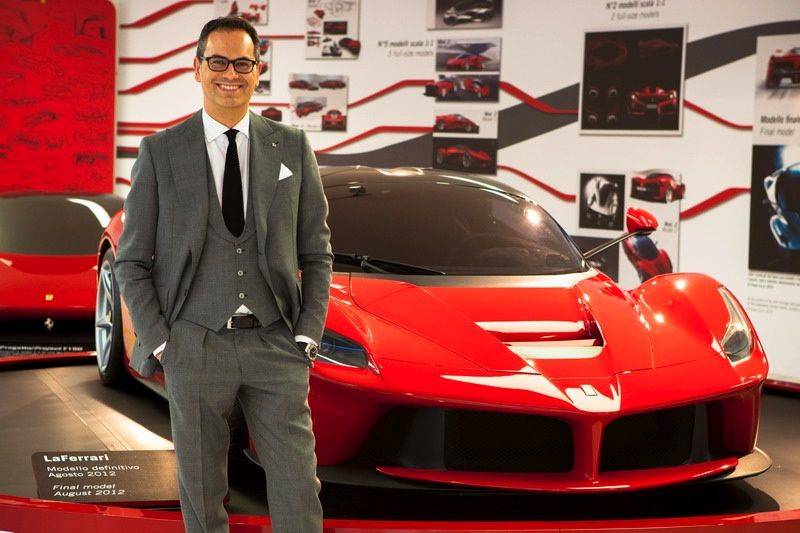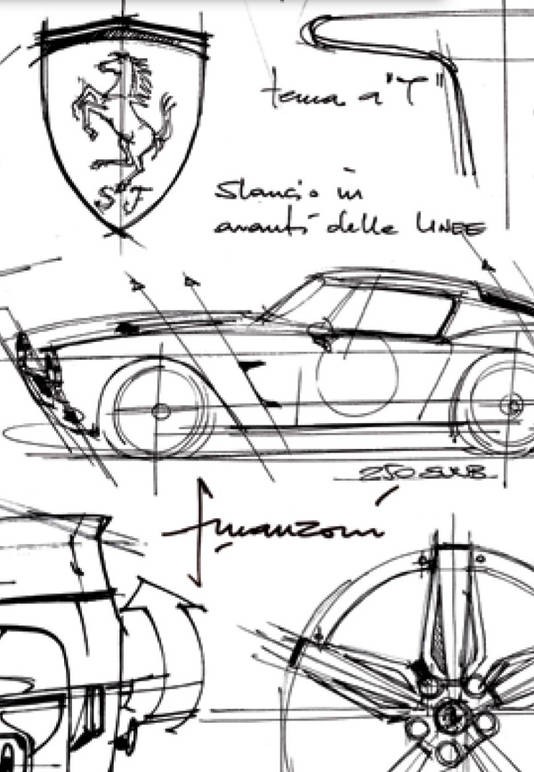Designing Your Dreams
Ferrari’s head of design Flavio Manzoni may be the most important name in style in the Italian automobile industry. A deeply proud Sardinian, the fifty-year-old designer already vaunted an extraordinary career before he came to Ferrari, where his design of the F-12berlinetta earned him the prestigious ADI Compasso d’Oro Award.
The first time we met was on a campaign to support recent flood victims in Sardinia, and we immediately began addressing a topic I hold dear: design. Manzoni was generous with his time, so I figured I would go back to him and pick his brain about that subject for this cover story. But this time our discussion began on a sad note. We talked about the great designer Massimo Vignelli, who had passed away in the meantime.
Vignelli, whose work has become a measuring rod for modern design, believed in functional beauty and the idea that a well-made object was timeless. He also believed that this beauty was achieved through design (which is timeless) rather than styling (a passing fashion).
What did Manzoni think? Could Vignelli’s idea be applied to car design? “Yes, definitely. Vignelli did extremely important work in the field of graphic design, but he was also an architect and, more broadly, an intellectual who saw design as a valid modus operandi across the board, “from a spoon to a city...” I’m fascinated by this vision.
I’m even more interested in the idea that design is such an elevated concept as to never grow old... Naturally, that’s true for cars too. Just think of the Citroen DS, the Fulvia Coupé di Castagnero, and prototypes like the Stratos Zero...
Design vs. Styling
What’s the difference between style and design for a car designer such as yourself? In fashion, the craftsmanship and sensibility peculiar to Italians make our best stylistic creations resemble real works of art.
But in automobile design, with its highly elevated functional and technological side, you cannot overlook the value of conceptual innovation, which must expand the so-called “semantic quotient.”
Design, on the other hand, is considered a “global project”; style is just a part of the process of development charged with defining the morphology of a product, with manufacturing its very essence, which is to say, communicating its content and the original intent.
So the key to good design is innovation?
Definitely. And this often occurs by redefining the architecture [of a product]. A lot of companies today limit themselves
to making an ultramodern look, to what we call styling. Design, on the other hand, must strike out on radically innovative paths... It’s fine to attend to the details and add surprising and modern touches, but only as long as the structure is being enhanced, too. It’s not there to cover up a lack of courage.
How important is tradition with respect to innovation?
Looking back in time, it seems as though everything has already been invented. But that’s not true. Not only is thinking of the future essential to survival, but research is always in motion. We have no idea what the coming years hold in store for us in terms of materials, technologies, propulsion systems. And don’t forget legislative changes. That’s why it’s very important to always be reaching forward. And I can’t forget what Le Corbusier said: “tradition is nothing but the uninterrupted chain of innovations.”
Italy in the World and in the U.S.
Do you think Italy’s aesthetic culture still has something to tell the world?
Yes. Italy has a history—in the auto- industry and elsewhere—that few
other countries in the world can claim. Nowadays it’s very important to embrace the international scene and understand that a product is made for the world, for very different latitudes. Having said that, staying true to one’s roots is essential for imparting an added value, to give those who choose our product a more gratifying
experience. Italians are experts at doing that.
You have lived and worked abroad. How did that experience affect you? What does working in Italy today mean for you?
I spent almost six years with Volkswagen. It was definitely a very formative experience. In another country you discover procedures and habits that are occasionally very different from the ones in Italy. I’m not just talking about day-to-day life but about the entire industrial system. That’s essential to someone in my line of work. But it doesn’t detract from my happiness about working in Italy again; roots are important, and a company like Ferrari combines initiative and the spirit of our country at a world-class level.
What do you think of the United States? Have you ever thought about living here? Honestly, I haven’t spent an extended period of time in the United States and I’m not sure I’d want to work in the American auto- industry. But when I think of a city like New York, I can’t help but appreciate the melting pot of cultures and customs that define it. Perhaps the most interesting thing about the US is its ability to marry different worlds... That’s become a global trend and is all the more important because of it.
At Ferrari
You’ve been directing Design Ferrari for a few years. How has that experience been?
My career at Ferrari has been exciting. I don’t know how else to put it. It’s probably the most demanding job of my career, yet that’s exactly why it’s the most rewarding. Keep in mind that when I arrived in Maranello, my job wasn’t to direct an existing organization but to create an internal style center, the first in the company’s history. That was the most difficult and interesting challenge. I still remember the numerous interviews I had to set up to select the young designers that now make up Team Ferrari. I remember feeling the need to create a winning team without egos, one that was capable of working together... For me, the human element has always assumed a fundamental importance, and at Ferrari I had the opportunity to create an extraordinarily positive environment from scratch.
Ferrari won the Compasso d’Oro Award for the F12 Berlinetta. How significant is that for you and the company?
The significance of the Compasso d’Oro may not be understood that well outside of in Italy, but receiving the award was a great honor for our design team. The products and designers who have received the Compasso d’Oro in past decades represent the best in Italian design... Receiving the award during this difficult period for the country makes us all the more proud and hopeful for the future.
“YouCanDesignEverything”
Massimo Vignelli used to say, “If you can design one thing, you can design everything.” You don’t just design cars. Can you tell us about your other work?
I think there’s one design methodology. Adopting the right intellectual criteria is just as important when designing a chair as it is when designing an automobile or a bookstore. That’s one reason I didn’t limit myself to cars. Recently, I personalized the famous JJ lamp by Leucos—a small but major masterpiece of Italian design. It was inspired by Sardinia, and proceeds from it have gone toward giving concrete aid for victims of the 2013 flood.
Designing the Future for Our Kids
To get personal for minute, do you ever think about how your children will see your design work? Do you seek their advice? What do cars mean to them? How do you see their city of the future?
My younger kid is still too small to appreciate his father’s designs, and my eldest is no longer interested in cars! Joking aside, I really like knowing their opinion. Kids are windows onto the future, and sometimes their opinions can open up unthinkable perspectives. Today there’s a lot of talk about “smart cities” and new models for living. I don’t know what will happen. I don’t know how our way of life will change. But I hope we’ll be able to hand down a society that, if not better or more just, is at least more balanced as far as concerns the environment and the exploitation of new energy resources. Car designers must confront those problems. It’s difficult, but I’m convinced that it will also stimulate new solutions.










































i-Italy
Facebook
Google+
This work may not be reproduced, in whole or in part, without prior written permission.
Questo lavoro non può essere riprodotto, in tutto o in parte, senza permesso scritto.